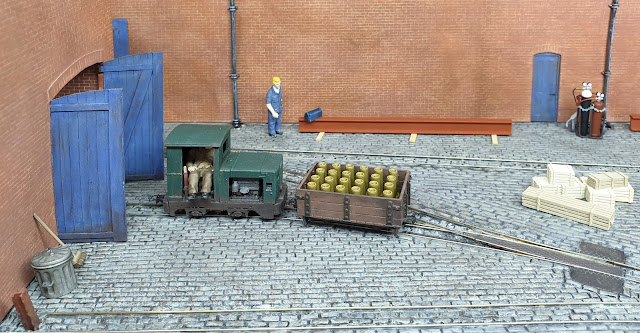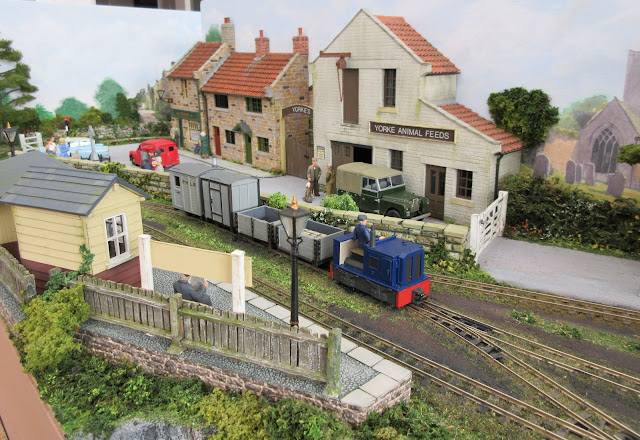O9 SCALE NARROW GAUGE RAILWAY MODELLING
A QUICK GUIDE TO COMPACT LAYOUTS IN LARGE SCALE (7mm) (IN MY OWN PARTICULAR STYLE)
For those new to the hobby and O9 scale
As a recent modeller in this charming minor scale, I would like to share my knowledge about this scale in the UK. Below is some basic information on Rolling Stock Sizes, Track, Rolling Stock Manufacturers and further Links. I hope this may help some people who are interested in modelling this charming scale. A characterful model railway can be built in 7mm scale in a small space. It can be compared with the small spaces used for a "009" gauge 4mm scale layouts, and an area much smaller than a "00" scale standard gauge one would require.
The scale/gauge combination:
"O" scale - 7mm to the foot, running on 9mm track to represent 15" or 18" gauge.
Three of my first kits. Wagons are resin kits by Unit Models, the loco body is a Shapeways 3D print by Tebee.
Description:
"O9" is used to represent 15" or 18" gauge narrow gauge railways typically built for industrial sites, private estates or more recently, tourist/pleasure railways. It is historically known as the "minimum gauge" to effectively transport useful loads/cargos via a small gauge railway.
UK Prototype Examples (historical and current):
Historically, the proving ground for the gauge was at the Duffield Bank Railway in Derbyshire where Sir Arthur Heywood first designed, built and tested locomotives, and also various rolling stock, at the end of the 19th century.
Other famous lines:
The Fairbourne Railway, Wales
The Ravenglass & Eskdale Railway, Cumbria
Woolwich Arsenal Railway, London
Chatham Docks, Kent
Eaton Hall Railway, Cheshire
Lakeside Miniature Railway, Southport
Bure Valley Railway, Norfolk
Perrygrove Railway, Forest of Dean.
 |
15" gauge Bure Valley Railway No.1 "Wroxham Broad" at Aylsham in 2011
|
There are different ways to approach O9 modelling:
1: Modelling small prototypes in the "minimum gauge" style used on garden, estate lines, or industrial lines.
2: Modelling tourist railway prototypes like the "Ravenglass & Eskdale Railway" using longer locomotives and bogie stock.
3: Modelling in a freelance - what I call "compressed narrow gauge" style - making a fictitious "estate-type" layout (a route I have chosen).
There are small manufacturers of basic "O9" scale kits for locomotives and rolling stock bodies (further details under "Locomotives & Rolling Stock" below).
Loco and wagons by Unit Models (resin kits)
O9 scale can also make use of several other commercially available products:
"N" gauge and "009" gauge chassis to power locomotives.
"009" track by Peco (or even "N" gauge track can be used).
"O" scale scenic kits, buildings and figures.
Parts from "00" gauge locomotives.
General "00" or "O" scale scenic materials.
Some sizes:
An O9 layout featuring small locomotives and 4-wheeled stock could fit on a 4ft x 2ft baseboard easily, modelling a scale area of 174ft x 87ft. In 4mm scale (OO or 009) you would be modelling a larger area of 304ft x 152ftin. There is an advantage though in that O scale the models are easier to see! - and as such more detail can be added.
This board is 43" x 20". The loop is 18.5" (470mm) long.
Depending on the length of some rolling stock, the train lengths are very similar to 009 scale. A 009 0-4-0 loco and five 4-wheel wagons is approx. 300mm. An O9 0-4-0 loco and five 4-wheel wagons is only approx. 320mm, despite the train being 75% larger in scale. This is because they are models of smaller prototypes.
(Just for comparison, below are approx. 00 scale (4mm) Standard Gauge small train lengths:
0-4-0 loco plus three GWR 4-wheeled coaches: 392mm
0-4-0 loco plus two Mk1 bogie coaches: 647mm
0-4-0 loco plus 4 wagons: 447mm).
See photos below of some of my own 009 stock for comparison:
Just for further comparison in another scale, these are the approximate dimensions for O-16.5 (7mm, 2ft 3" gauge) short 0-4-0 and 4-wheel stock.
Many 15" gauge lines have rolling stock approx. 3ft 6" wide (24.5mm), though many kits are modelled about 4ft wide (28mm).
It must be remembered that because the O9 stock is slightly wider, loops and sidings should be slightly longer to allow trains to pass each other. For instance, the loco and five wagon train in 009 would need a loop of approx. 370mm long (from head of turnouts) to allow room for trains to pass, a similar O9 train would need a longer loop length of approx. 450mm long. A slightly wider clearance would also be needed either side of the track to clear scenery and platforms etc., - approx. 10mm either side of the rails.
Different allowances for long locomotives and bogie carriages would have to be considered depending on the type used. A 4mm 009 Lynton & Barnstaple 2-6-2 plus three bogie carriages is approx. 595mm long. A similar 7mm O9 bogie train would be about the same length (unless perhaps a long Romney Hythe pacific loco is used!).
For my first attempt in coach building, I decided to build two short 2-compartment bogie coaches using Hornby 00 scale GWR 4-wheelers as the basis of the body, they are 105mm long. They run well but they are really too wide at 33mm (over 4ft 6ins).
From a Hornby 00 scale 4-wheel coach, using Peco 009 bogies
Then next I built two scratch built coaches which are slightly shorter at 95mm:-
Scratch built, using Peco 009 bogies
Track & Radii:Commercial 009 track and turnouts can be a good compromise to represent 15" track. Strictly speaking, the sleepers are not long enough and are spaced too close together. But the sleepers can be hidden slightly in ballast and ground cover to disguise the appearance. Peco manufacture "irregular" and "mainline" types in flexible and setrack. It is also possible to adapt sleeper appearance and spacing by cutting the webbing linking the sleepers, or even make hand-built track to replicate Heywood or Jubilee track using P.C.B. sleepers.
A totally simple (but less prototypical) approach could be to use "N" gauge "setrack" or flexible track, and turnouts.
These small trains will happily run round sharp curves of down to 190mm (7.5") radius. The wagons in the photo below are on such a curve, but are closer together because of my close-coupling method. My own layouts curves are between 8 and 9 inch radius.
Locomotives & Rolling Stock:
I know of no ready-to-run stock in O9 scale.
Like most other railway stock kits, O9 rolling stock models consist of three main elements the BODY, the CHASSIS and the COUPLINGS.
Body kits are available as simple resin kits, 3D printed models or brass kits. Most are reasonably priced too, but the cost of the chassis, couplings and other added details will increase the amount.
Here are a few manufacturers:
Frizinghall Models & Railways, Unit Models (resin kits) Unit Models They make a loco, several types of wagons and other O scale scenic accessories
A simple two-part resin kit from Unit Models along with a typical Peco N gauge Chassis Kit and the finished model.
Many types of loco, wagons and coaches in brass etches.
(Please note: kit manufacture is affected by Covid19 restrictions due to personal work commitments).
Photo shows a brass fret from Minimum Gauge Models of a modern Industrial Diesel, also an N gauge Kato Tram chassis, and a similar completed model. These brass kits can be soldered or glued.
Barry makes three locos, several wagons, a closed coach, and other scenic accessories with good mouldings. Use the contact info to obtain a Paypal invoice for any requirements.
A completed Barry McDowell Diesel Locomotive kit
Two completed Barry McDowell timber two-plank open wagons (sold in pairs)
Shapeways Tebee Models (3D printed) Tebee Models (other O9 manufacturers are also on the Shapeways site). Many types of loco, wagons and coaches.
A Tebee models 3D printed basic loco body as purchased, and the completed model with added hand rails, name plates and driver running on a Kato 11-103 chassis. This body was purchased made in the "white natural versatile plastic", it is very light but quite strong, and requires fine sanding to get the surfaces smooth. Other finer types of plastic are available that do not require so much preparation and also show details better.
Floyd Kraemer (Ebay shop) Floyd Kraemer . Excellent 3D printed Diesel locos and wagons, using a fine ABS type resin..
A Ransomes Rapier 80/1937 print by Floyd Kraemer
Recently, (November 2022) Fourdees Models have introduced an O9 locomotive kit (a George England "Prince" type) and also a pair of passenger coaches as a kit. Fourdees Limited
A1 Models of Doncaster - Loco kits and detailing parts. Look for their
It is also possible to modify Hornby "00" gauge small locomotive bodies by making cabs and chimneys taller and mounting them on a suitable "N" gauge chassis.
Each body kit will usually recommend the type of chassis to use. Many locomotives run on the Kato 11-109 N gauge 4-wheel Tram Chassis (old No: 11-103). But for steam locomotives with visible motion and wheels other makes of chassis can be used if they fit the body ie: Graham Farish, Minitrains, Fleischmann. Mark Clark of "LocosnStuff" builds 7mm narrow gauge chassis, website: LocosnStuff
Where a wagon kit does not contain the chassis, N gauge wagon chassis can be used for wagons such as Peco NR-119, NR-120, NR-121, NR-122 or NR-123 kits, or the chassis from ready to run "N" gauge wagons.
Most 009 bogies can be used for bogie coaches such as the Peco GR-106 or Dundas Models DM-11. Dundas Models have many useful chassis and couplings.
Couplings: This is down to preference, but in general any 4mm 009 couplings can be used made by Peco, Greenwich or Bemo. Sometimes the chassis or body needs modification to fit them securely, and it is important to mount them at a consistent and correct height using a height gauge - generally 6mm from rail to top of buffer.
There are many other makes of couplings: "N" gauge couplings, Dapol Magnetic or different types made by Kadee, amongst others.
Other Links:
The 7mm Narrow Gauge Association, a society for 7mm narrow gauge modelling, includes O9 and also dedicated to O-16.5 and On30 scales: 7mm Narrow Gauge Assoc. 7mm Narrow Gauge Association O9 Gallery page: O9 Gallery The Association also produce a 76-page handbook on minimum gauge modelling called "Going Minimum Gauge".
Colin Peake's blog featuring his O9 and 009 models including his coastal pleasure line "Shifting Sands":-
"Shifting Sands" Photo: Copyright C. Peake
Steve Clulow's blog featuring O9 and 009 models including his O9 layout "Thomas & Sons":-
"Thomas & Sons" Photo: Copyright S. Clulow
More details of my own O9 projects are on this site (as under).
A small operating diorama built in an upturned drawer, track base size only 20" x 4.5" (510 x 120mm).
A scene on the authors "Raven Hill" layout.
A maintenance shed scene on the authors "Pye Rigg Works" layout.
E&OE.
As far as possible, all information correct at the time of writing (Dec. 2021)
























No comments:
Post a Comment